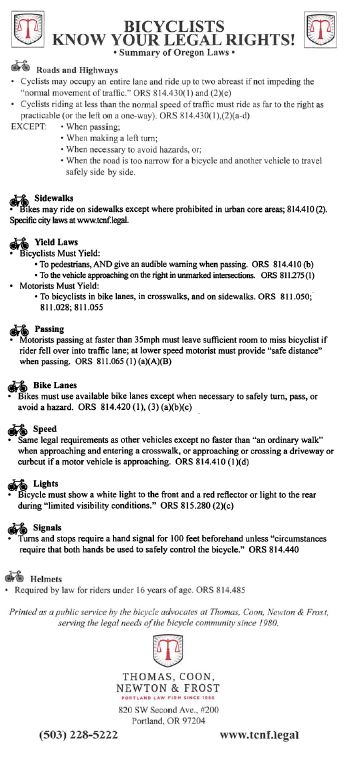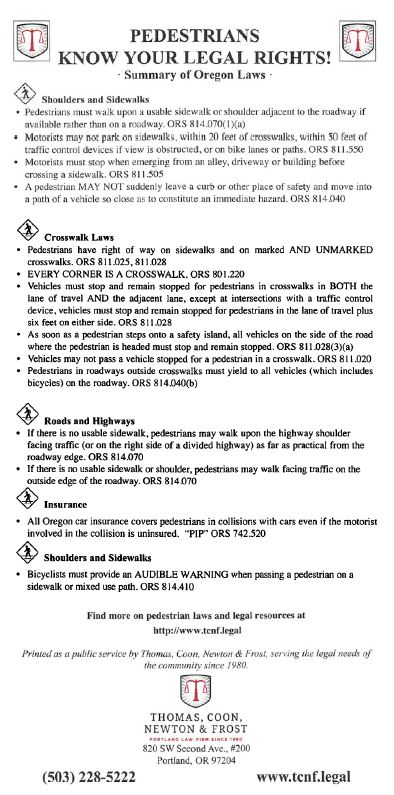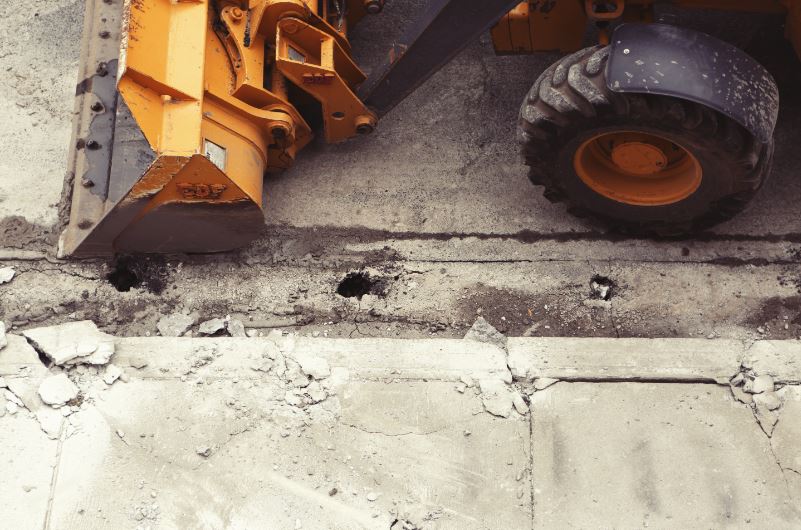A quick reference guide to the legal rights of bicyclists in the state of Oregon, provided by the bike and pedestrian lawyers of Thomas, Coon, Newton & Frost.

Shareable pdf file here.

A quick reference guide to the legal rights of bicyclists in the state of Oregon, provided by the bike and pedestrian lawyers of Thomas, Coon, Newton & Frost.

Shareable pdf file here.
A quick reference guide to the legal rights of pedestrians in the state of Oregon, provided by the bike and pedestrian lawyers of Thomas, Coon, Newton & Frost.

Shareable pdf file here.
The other day I was driving along Tualatin Valley highway during afternoon rush hour. Both lanes in each direction were filled with cars. As I drove through an area where construction was occurring I saw that the crew had stopped work for the day and left a furled up construction sign on a tripod stand right in the middle of the bike lane. Whoever did it was not thinking about a commuter bicycle rider coming along and having to leave the bike lane and go into heavy traffic to avoid the sign. This sort of thing is all too frequent and is dangerous for everyone, but so are the wider effects of construction sites. Whole neighborhoods can feel the impact of construction on a single street-corner.

All too often bike lanes, multi-use paths and sidewalks are closed to the public far longer than is necessary. The danger to the public increases as pedestrians and bicycle riders scramble to reconfigure themselves into the available spaces to get around the construction zone. This scramble creates deaths and injuries that are foreseeable and avoidable.
The easy fix for these hazards to citizens is to employ good traffic control practices. Most construction sites on roadways have requirements for Traffic Control Plans (TCP). These TCPs must be filed as part of the construction permit process where the public way will be impacted by construction. All too often “traffic control” means setting up a system merely to divert motorized traffic around the construction site. Often this means closing adjacent sidewalks and bike lanes. It is important to protect the public from arbitrary and unnecessary closures of the public way including that of sidewalks and bike lanes by complaining to public officials when dangerous closures occur. And, as in the example provided above, it is imperative for safety that construction companies train workers to remove closures from the public way as early as possible to restore the natural traffic flow and right of way.
Collecting photographs of examples of unnecessarily dangerous public way closures can help raise awareness of these issues and encourage communities to reprioritize and to recognize the importance of non-motorized traffic. In 2016, local advocacy groups The Street Trust and Oregon Walks placed direct pressure on Portland city officials by creating the hashtag #WorkZoneWTF as a way to collect the most glaring examples of closures of the public way on social media. The many examples that flooded in created a graphic collection of the unnecessary hazards created by failing to recognize the rights of non-motorized road users.
After this effort, Portland implemented a city-wide construction traffic policy change in July 2016. The City Council voted 5-0 to adopt a new resolution changing the permitting of TCPs so as to preserve the public way for vulnerable users: “We wanted to make sure the last resort was to close the sidewalk and to close the bike lane,” said Faith Winegarden, the Portland Bureau of Transportation (PBOT) permitting manager. “We want to make sure every option has been explored.” Bike Portland published an article on the policy change which can be found here.
Portland has continued to make good progress in this regard, but the state of Oregon has fallen behind. As part of a biennial Oregon Department of Transportation (ODOT) Work Zone Safety Audit for 2017, ODOT’s reviewers gave some of the lowest scores to bicycle, pedestrian and ADA accommodations like continuous routes through construction zones, signage marking these routes, and ADA compliance. According to ODOT, these low scores mean that these areas “[need] additional attention,” which led them to update their 2018 advisory materials on standard site specifications and TCP design. And there’s more work to be done. ODOT’s plans for 2018 do consider non-motorized road use in urban environments, but more attention should be paid to the needs of non-motorized road users in rural areas. Pedestrian and cyclist traffic still isn’t being afforded the same attention and protection as motorized road use at the state level.
Here are a few of the measures Portland has adopted to limit the effect of construction sites upon pedestrians and cyclists:
These measures might seem like common-sense, and they might seem like the minimum we ought to expect from city policy, but these protections are by no means guaranteed outside of Portland. I hope ODOT will follow PBOT’s lead and implement similar protections statewide.
Yes, in Oregon, a person can ride a bicycle on a sidewalk even if the street they are riding along has a bicycle lane.
Oregon is a mandatory sidepath law state, which means that the law requires a bicycle operator to use a bicycle lane if one is present instead of riding in the mixed traffic lane. ORS 814.420 Failure to use bicycle lane or path prohibits a person from “operat[ing] a bicycle on any portion of a roadway that is not a bicycle lane or bicycle path when a bicycle lane or bicycle path is adjacent to or near the roadway.”
However, the law only restricts bicycle operators from operating on the roadway when there is a bicycle lane and the sidewalk, while part of the highway, is not part of the roadway. The roadway is “the portion of a highway that is improved, designed or ordinarily used for vehicular travel, exclusive of the shoulder.”
I encounter this question a lot in the bicycle law clinics I teach.
The short answer is: No. There is no statewide legal requirement to walk a bicycle in a crosswalk.
There are, however, a couple of laws to keep in mind when riding up to or in a crosswalk.
First, when a bicyclist in Oregon is riding on a sidewalk and is approaching or entering a crosswalk (and also a driveway, a curb cut, or a pedestrian ramp) and a motor vehicle is approaching, the bicyclist must slow to the speed of an “ordinary walk” while approaching and entering. ORS 814.410(1)(d) Unsafe operation of bicycle on sidewalk.
Second, a bicyclist is entitled to the same rights and responsibilities as a pedestrian while in a crosswalk. ORS 814.410(2). What this means is that the requirement that a motor vehicle stop at a crosswalk when a pedestrian is crossing the roadway also applies to bicyclists. ORS 811.028 Failure to stop and remain stopped for pedestrian. Oregon law even requires cars to stop when any part of a person’s bicycle moves onto the roadway in a crosswalk with the intent to proceed across. ORS 811.028(4). A bicyclist can’t leave the sidewalk into the path of a car, though, if the car is so close it constitutes an immediate hazard (like it wouldn’t be able to stop safely), even if the bicyclist is entering a crosswalk. ORS 814.410(1)(a).
Third, a bicyclist must always keep in mind that while riding on the sidewalk and in crosswalks is legal under state law, cities have the right to make it illegal under their city ordinances, so it is important to know the laws of the cities you ride in.